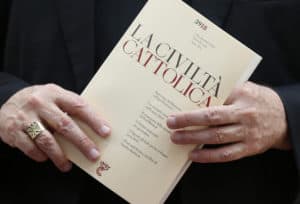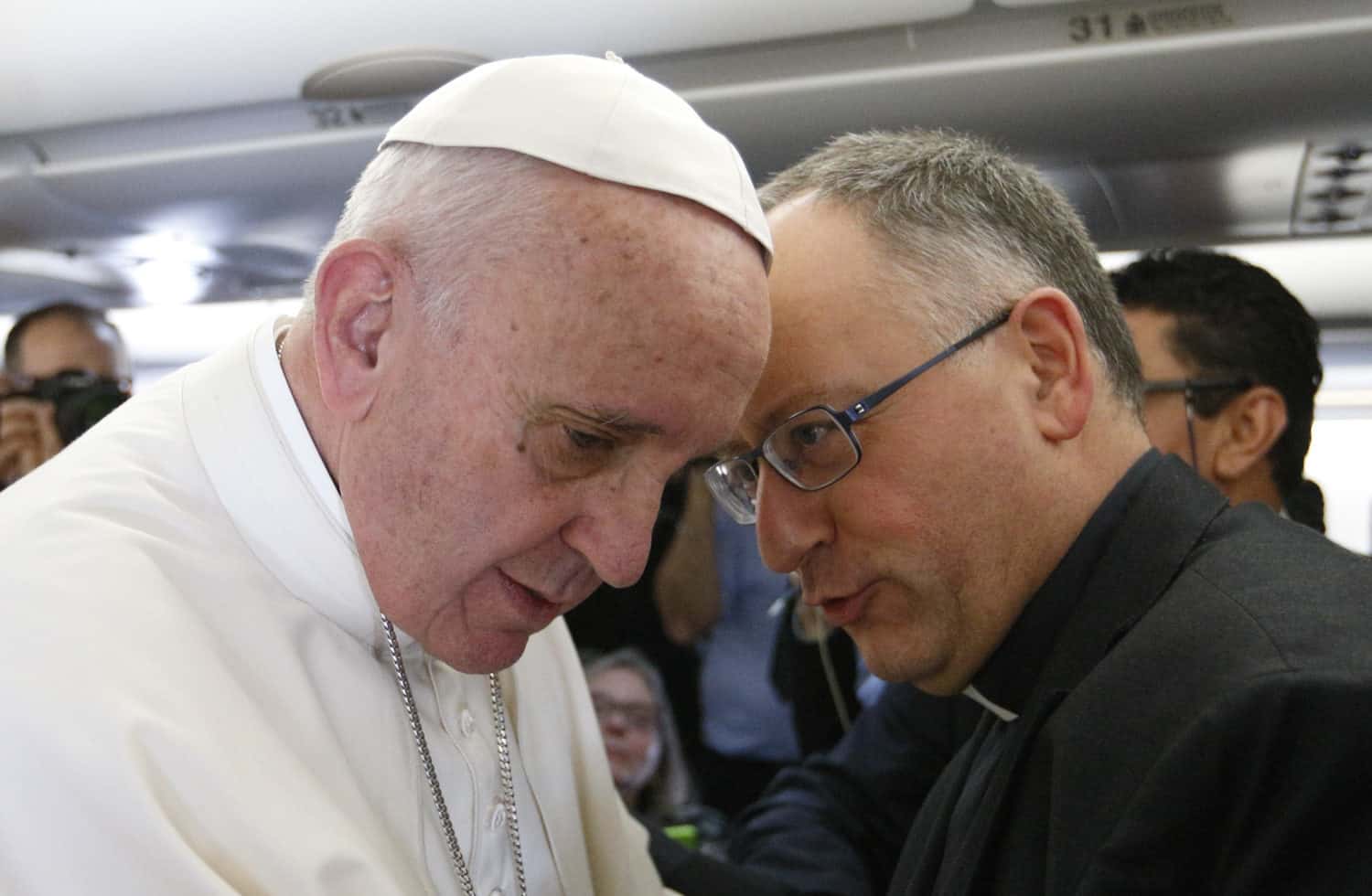Be sure to check out Danny Gustafson’s counterpoint to this essay!
While the reaction to the recent Civiltà Cattolica article by Fr. Antonio Spadaro, S.J. and Rev. Marvelo Figueroa has been incredibly diverse, analysts as diverse as First Things (especially Altieri, and Weigel) and Commonweal (Annett, and Faggioli) have treated the article at depth and many agree that it is a “must read.”
I agree that this article is a “must read” for people interested in the dialogue concerning Catholic participation in American political life, but I disagree about why. First, this article should be read because it is a curious example of exactly what is wrong with contemporary discourse. Although the authors might have intended to prompt a healthy conversation, and I think they have some great points in mind, the article misses its mark and falls into many of the pitfalls that prevent cooperation toward the common good and undermine authentic dialogue.
Second, the article should be read because the subject matter it was attempting to discuss needs to be wrestled into rational analysis if Catholics are going to be able to cooperate in leading the country towards a greater commitment to the common good. Still confused by the last presidential election, the American people need patient voices to guide us to a better understanding of our political reality and a more effective expression and realization of our deepest values. These authors, in this article, do not provide those voices. In fact, I predict that if those on the same side of the political spectrum continue with the potentially alienating language found in the article by Spadaro-Figueroa then they could very well end up facing a second Trumpian term, further Brexitesque surprises, and a continued rightward shift in American and European politics.
As a Catholic ethicist who considers himself a moderate conservative, and who voted with great difficulty in the presidential election, I am sympathetic to many of the points made in the article and to the general suspicion of the Catholic-Republican (and Catholic-Democrat) uncivil unions. So let me explain three reasons why I think this article falls so short of its task. First, it ironically demonstrates the conflictual mode that it supposedly condemns. Secondly, and most crucially, it fails to define who exactly it is talking about and is, therefore, a precariously ambiguous ad hominem attack. And finally, it is an almost perfect manifestation of the conflictual mode of discourse that seeks to land punches instead of persuade. I do not know what the authors were trying to accomplish, but walking through my reactions to the article as they developed while I was reading it will shine light on how each of these three issues can be seen to be at play therein.
I received a link to the article from a conservative friend who prefaced it with, “We finally see what Pope Francis thinks of US conservatives.” Suspicious of such a pretext, I opened the article with initial excitement because we are certainly in need of a careful and fair analysis of the uncomfortable marriages between Catholics and the dominant political parties in the US. I was hoping for a Tocquevillian analysis of the matrix of the American political reality from a foreign point of view. The American situation is a fascinating matrix composed of varying interpretations of various Constitutional elements, especially the First Amendment and the Constitutional limiting of the role of the federal government in effecting the common good. This matrix is particularly American and most of the differences between political “conservatives” and “liberals” of the same basic world-view presuppositions (like Catholics considered as a bloc) extend from the legitimate diverse interpretations within this matrix. Informed analyses from Italian and Argentinian perspectives (which operate within a very different matrix) could be rather helpful. As many a scholar tends to do when reading a journal of this repute, I flipped to the notes to see what other authors we would be treating. My heart fell when I saw the three paltry little notes of perplexing provenance. Were Spadaro and Figueroa really using a platform of this stature to engage the decidedly fringe but curiously influential views of an American blog? No inclusion of articles from America Magazine, First Things, nor mention of John Courtney Murray, H. Richard Neibuhr, or his brother Reinhold?
Although the article does not approach the American situation from the context of the matrix I believe is most pertinent, I continued to push forward, willing to follow the authors in their hastily constructed history of a fascinating phenomenon in evangelical Christianity. Having previously been an Evangelical Christian myself, I could recognize the contours of the eschatological vision they were drafting, even if they chose odd sources, imposed an exogenous interpretive structure, and operated with opaque presuppositions. I remembered reading Hal Lindsey, Left Behind, and This Present Darkness when I was a kid, so I could recognize some of my own Evangelical experience in their hasty sketch.
But my willingness to follow turned quickly to confusion when the authors deployed the word “Manichaean”. The popular application of the term “Manichaean” to a simple ideological dualism might be acceptable when, for example, Zbigniew Brzezinski used the phrase “Manichaean paranoia” in reference to George W. Bush’s foreign policy a 2007 episode of The Daily Show with Jon Stewart. But one would expect greater precision from a man with the theological training of Spadaro. There can be no confusion that one can side definitively in an ideological battle, or even a literal war, without even a hint of Manichaeism. True Manichaeism insists that goodness and evil inhere in things and not in ideas: it is a radical rejection of God as omnipotent, providential, and the unique creator. I’m pretty sure Augustine would frown at this figurative use of this ancient religion. And I’m certain that both of Pope Francis’s immediate predecessors would furrow their brows at the insinuation that taking a definitive stand ideologically is inherently dangerous or antithetical to the gospel. The article might have hit its intended mark had it used the categories established by H. Richard Niebuhr in Christ and Culture instead of making the odd, and Augustine-in-the-grave-turning, misdiagnosis of Manichaeism. The subsequent wondering about who these people are who practice such a radical ontological dualism leads us to the greatest confusion of the whole article and the reason why I believe its good points are obscured by its potential divisiveness.
As I continued to read I started wondering in earnest, “Who are the authors talking about?” More personally, I was curious about how I was to engage the article. Was I part of the intended audience, the intended ad hominem target, or a mere spectator in an ironic campaign of fear-mongering? (Personal note: of the mongerings, fear is my least favorite, since it almost always extends from a total lack of interest in the underlying values and principles of the “other side”.)
 When the authors finally turn their attention to la civiltà cattolica proper, in the section that begins with “Fundamentalist ecumenism,” my heart sank. Drawing exclusively from the evidence of the article, alas, it seems I can consider myself as part of the intended ad hominem target. Let me explain why, because here is where the conflictual mode of the article comes into clear relief. As I read I felt like the authors were attempting a three-punch-combo to annoy/defeat their foe and entertain/delight their sympathizers.
When the authors finally turn their attention to la civiltà cattolica proper, in the section that begins with “Fundamentalist ecumenism,” my heart sank. Drawing exclusively from the evidence of the article, alas, it seems I can consider myself as part of the intended ad hominem target. Let me explain why, because here is where the conflictual mode of the article comes into clear relief. As I read I felt like the authors were attempting a three-punch-combo to annoy/defeat their foe and entertain/delight their sympathizers.
The first is more of an “eye-poke” than a punch. It is executed via the association of the Catholic conservatives—whom they call “Integralists” without sufficient definition—with the previously defined “Manichaeism.” Augustine flirted with Manichaeism before his conversion to Christianity. He subsequently, and vehemently, fought against the religious movement and its leadership. I don’t know if Spadaro and Figueroa were intentionally connecting Catholic conservatives with Augustine’s later nemesis, but it’s a connection that is potentially provocative and annoying to a group that often self-identify as Augustinians.
After the eye poke, the first “jab” comes in the insinuation that the mode of action of this group of “Integralists” (a term the authors have left quite mysterious) is one of a bastardized “ecumenism”. The authors admit that there is an irony to this punch, since they insist that the Integralists “condemn traditional ecumenism.” But it is in the definition of this “well-defined world of ecumenical convergence” that the true irony is found. Instead of anything that bears any resemblance to true ecumenism (either the formal ecumenism that has followed Vatican II or the practical ecumenism I take part in every day as a Navy chaplain) according to the article the ecumenism of which the Integralists are accused is nothing more than a mere Venn overlap of social concerns. What are the elements that are found within the “well-defined” Venn overlap presented by Spadaro/Figueroa? The article says that they are “abortion, same-sex marriage, religious education in schools and other matters considered moral or tied to values.” This Venn overlap is what defines these nasty Catholic Integralists. I assume that neither Spadaro nor Figueroa would agree with this assertion….but it’s what the article actually says. This is where the train comes off the tracks and deep confusion follows.
The final “knockout punch” comes in the assignment of a motivation to the Catholic Integralists (part of which I now seem to be associated through the Venn characteristics). The authors state explicitly that the motive of these Catholics is hate…manifested in wall-loving, culturally purifying actions and satiated best at the wells shared with terrorists and jihadists. The bogeyman has fully arrived, and his mode and motive have been established (no matter how foreign both may be to any actual practitioner of whatever Catholic Integralism is). This is a purely conflictual mode. But the specifically embarrassing problem is that any novice practitioner of spiritual direction, counseling, or pastoral care should know that the exogenous assignment of motivations violates one of the few inviolable principles of the field, i.e., it is impossible to know the motives of other people unless they willingly share those motives. In fact, the only answer to the question posed in the title of this article is: only Spadaro and Figueroa know what they intended. Nevertheless, those authors assign a fully articulated mode and motive to these insidious Integralists. This hijacking of the interiority of other people is a subtle form of emotional violence that is all too common in contemporary discourse and inevitably causes resistance and division in those with opposing views. It is a form of ad hominem demonization. Instead of refuting the ideas as expressed it simply states that those ideas can be dismissed because they extend from essentially evil motives, using only ideological pressure instead of persuasion. Therefore, at this point, the camps necessarily divide. Those on the conservative end of things, who share some if not all of the elements in the deplorable Venn overlap, become defensive, and those on the liberal end of the spectrum gather behind the authors insisting that this is a long-delayed and much-needed critique. (Little more than saying, “Yeah! What they said!”) I have no idea what the authors intended to accomplish, but this reaction is completely understandable in today’s climate of ideological hostility.

U.S. President Trump, whom Spadaro and Figueroa argue has been likened to the Emperor Constantine by some on the Religious Right. (CNS photo/Carlos Barria, Reuters)
My final emotion in reading the article was one of bewilderment. The fact that an article that warns against the evils of one group’s aligning their theological and political ideation in the public realm ends with a strong appeal to the geopolitical theory of the world’s most authoritative religious figure is a delicious, although indigestion producing, irony. After the insidious opponent’s mode and motive have been identified by the authors, while their own presuppositions and motives remain mostly obscured, the official geopolitical position of the current Pontiff is thrust forward as the solution to the problem. I am deeply sympathetic to Francis’s vision; however, since the Pontiff’s approach to this topic is so different than his immediate predecessors, neither of whom hesitated to make judgments about the relative value of various ideological systems, it is a surprising appeal to authority and it left me bewildered. From the article it seems that for Spadaro and Figueroa it’s ok to make direct appeals to religious authorities and employ ideological presuppositions when engaged in public life—as long as they are authorities and presuppositions with which they agree. I sat back and thought, “Well, this is going to go badly. Conservatives will feel offended and liberals will titter with glee at having their own presuppositions echoed back at them.” And over the next several days it happened exactly that way.
My brothers and sisters of fides quaerens intellectum (faith seeking understanding), please don’t let this most recent setback to productive dialogue obscure the path forward or diminish our commitment to ending the conflictual model. When engaged in dialogue with someone of a differing view don’t be afraid of conflict, shy away from disagreement, or be afraid of making judgments with respect to ideas. But, in order to avoid falling into the conflictual model, follow these simple steps: 1) make clear and manifest your own presuppositions and motivations (even though this renders you more vulnerable); 2) attempt to understand the position of the other party in terms of their hierarchy of values; 3) express your opinions in terms of your hierarchy of values; and 4) do not assign exogenous presuppositions or motivations to the other party but allow them to establish these for you. We can move forward, but we have to stop the adolescent conflictual mode of discourse. It might not produce much click-bait, enjoy the high-fives of those in our own echo chamber, or help the web stats of our blogs…but it will help us advance as one unified Body of Christ.


